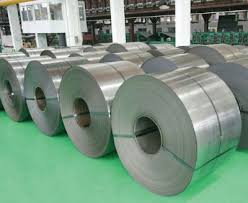
South Korean Steel Sector Faces Rise in Chinese Imports amid Upturn in Shipbuilding Industry

This is because South Korea was U.S.’s one of the major steel exporting countries over the years and with new trade barriers in place by U.S., South Korean steel firms have to either consume their production in the domestic market or have to find new destination for exports.
Amid this turmoil, the major concern for South Korean steel mills is the increasing penetration of Chinese steel products especially steel plates in the domestic market.
South Korea's shipbuilding sector recovers
The domestic steel demand in South Korea has recently observed an upturn especially from the ship building sector. As per the industry research, helped by growing demand for high-end vessels such as large container ships, oil tankers and vessels used to transport liquefied natural gas, South Korean shipbuilders have increased new orders 30% in the first seven months of 2018. The Korean companies have won 42% of new commercial ship orders in first seven months against Chinese and Japanese receiving 33% and 11% orders.
In conjunction with the positive current demand, the outlook for the offshore energy platform business, which has caused big losses for Korean shipbuilders since 2014, is also improving, helped by oil prices rallying to USD 80 a barrel for the first time in four years.
This burgeoning demand in Korea’s shipbuilding sector subsequently calls for rise in consumption of steel plates which is a key raw material for shipbuilding. However, industry analysis shows that there is increase in imports of steel plates from China.
The rising imports of Chinese steel plates in Korea
According to the Korea Iron and Steel Association (KOSA) on October 17, thick plate imports to the Korean market in Sep’18 amounted to 149,488 tonnes, a monthly high. Korea’s thick plate imports stayed at less than 100,000 tonnes until Feb’18, but have since grown steadily and rose nearly 60% from the beginning of this year.
In 2016, 220,164 tonnes of thick plates was imported per month on average, but last year, the volume dropped to an average of 102,205 tonnes per month. Recently, however, import volume has been on the rise again. In particular, imports of Chinese thick plates, which account for more than 60% of Korea’s total thick plate imports, are increasing significantly.
In Sep’18, Korea imported 84,236 tonnes of Chinese thick plates, which means their import volume more than doubled from the beginning of this year (The average of the Jan’18 to Feb’18 period: 38,595 tonnes). This year, Korea’s average monthly thick plate imports from China already exceeded those of last year (63,947 tonnes).
This spike in thick plates import is a big threat to Chinese steelmakers such as POSCO, Hyundai Steel and Dongkuk Steel Mill also because Korean steelmakers have increased their plates prices twice this year amid rising raw material cost. The average price of Korean thick plates over the past one year stood at 600,000 won per tonne whereas currently the price is standing around 700,000 won per tonne. The hike in prices of Korean steel plates is also one reason for the increase in Korea’s imports of Chinese steel plates.
Difficulties for South Korea to counterattack China
Recently, the Chinese government’s policies for steel production cuts have shown a sign of easing. Some experts forecast that as China is experiencing difficulties due to the trade dispute with the U.S., it will allow steelmakers to ramp up steel production again, shifting its focus from solving environmental problems to vitalizing the Chinese economy. As Chinese steel capacity is 15 times higher than that of South Korea’s steel sector, a little rise in Chinese material will be a big blow to the Korean domestic steel sector.
The Korean steel industry will be hard pressed to find a suitable countermeasure against Chinese steelmakers in the possible price war. This is because it is difficult for the Korean government to take actions such as imposing anti-dumping duties or initiating a safeguard as Korean government’s sanction on Chinese products may ignite a friction between Korea and China in terms of politics and diplomacy and lead the Chinese government to retaliate against Korean steelmakers that have moved into China.


Trump weighs using $2 billion in CHIPS Act funding for critical minerals

Codelco cuts 2025 copper forecast after El Teniente mine collapse

Electra converts debt, launches $30M raise to jumpstart stalled cobalt refinery

Barrick’s Reko Diq in line for $410M ADB backing

Abcourt readies Sleeping Giant mill to pour first gold since 2014

Nevada army depot to serve as base for first US strategic minerals stockpile

SQM boosts lithium supply plans as prices flick higher

Viridis unveils 200Mt initial reserve for Brazil rare earth project

Tailings could meet much of US critical mineral demand – study

Kyrgyzstan kicks off underground gold mining at Kumtor

Kyrgyzstan kicks off underground gold mining at Kumtor

KoBold Metals granted lithium exploration rights in Congo

Freeport Indonesia to wrap up Gresik plant repairs by early September

Energy Fuels soars on Vulcan Elements partnership

Northern Dynasty sticks to proposal in battle to lift Pebble mine veto

Giustra-backed mining firm teams up with informal miners in Colombia

Critical Metals signs agreement to supply rare earth to US government-funded facility

China extends rare earth controls to imported material

Galan Lithium proceeds with $13M financing for Argentina project

Kyrgyzstan kicks off underground gold mining at Kumtor

Freeport Indonesia to wrap up Gresik plant repairs by early September

Energy Fuels soars on Vulcan Elements partnership

Northern Dynasty sticks to proposal in battle to lift Pebble mine veto

Giustra-backed mining firm teams up with informal miners in Colombia

Critical Metals signs agreement to supply rare earth to US government-funded facility

China extends rare earth controls to imported material

Galan Lithium proceeds with $13M financing for Argentina project

Silver price touches $39 as market weighs rate cut outlook

















